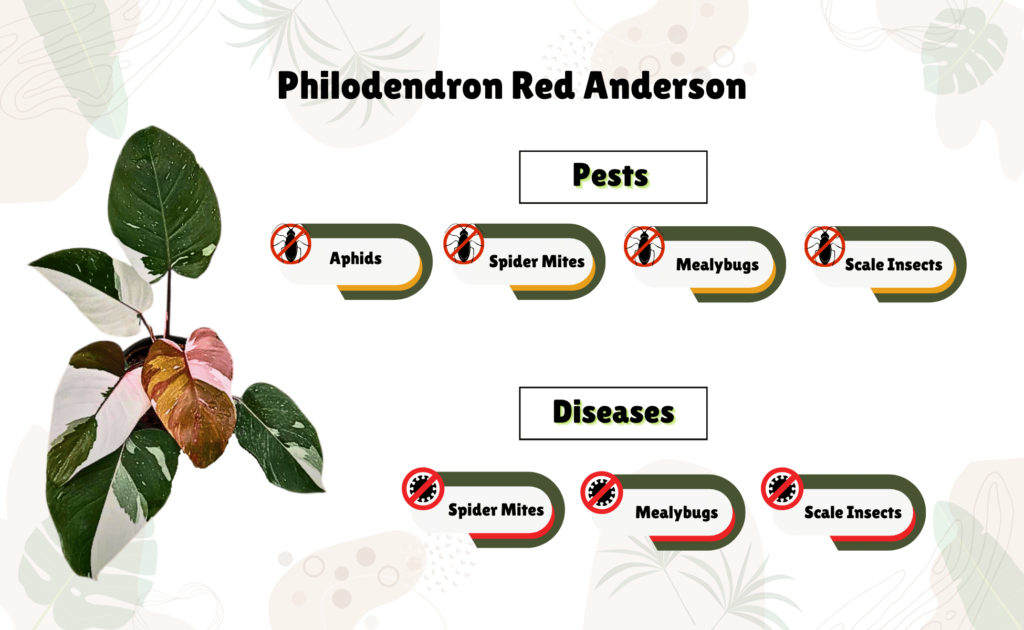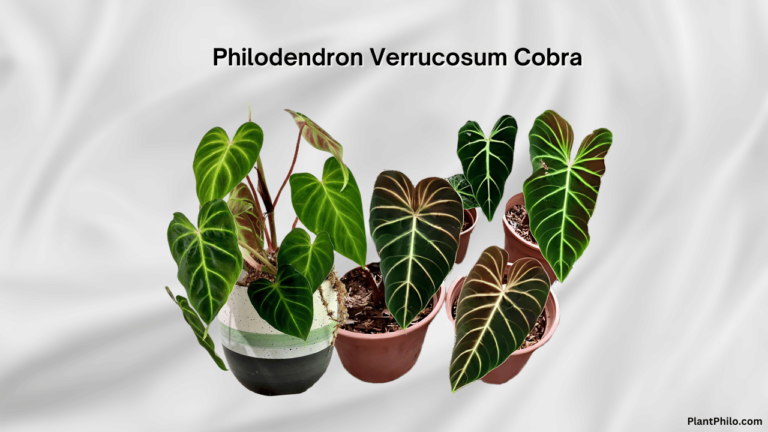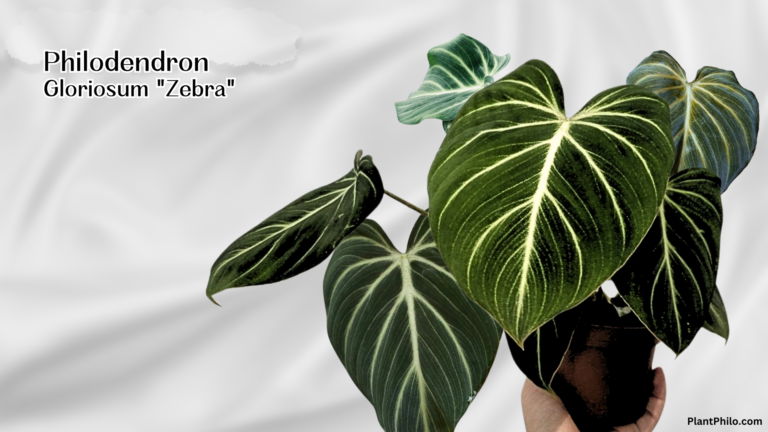Philodendron Red Anderson: Light, Water, Soil Recipe, Propagation & More
If you’re seeking a plant that’s both easy to care for and visually rewarding, the Red Anderson Philodendron is your perfect match. This guide will walk you through every step, ensuring your plant thrives and becomes the envy of all your plant-loving friends.
Starting with the basics, you will need to plant it in well-draining soil and place it where it gets bright, indirect light. Red Anderson Philodendrons thrive in bright, indirect light, but direct sunlight can scorch their leaves. A north or east-facing window is usually the best spot. Understanding these specific light requirements can make all the difference in the health of your Red Anderson Philodendron.
Key Takeaways
- Ensure bright, indirect light for healthy growth.
- Well-draining soil and proper watering are crucial.
- Follow simple propagation steps for new plants.
Getting Started with Your Philodendron Red Anderson
Starting your journey with a Red Anderson Philodendron involves understanding its unique needs. Ensure you select the right pot size and soil to keep it thriving.
Philodendron Red Anderson: At a Glance
| Aspect | Ideal Conditions | Tips |
| Light | Bright, indirect light | Near a window with filtered sunlight, avoid direct sun |
| Water | When top inch of soil is dry | Thoroughly water, avoid overwatering |
| Soil | Well-draining mix (peat moss, perlite, orchid bark) | Use a pot with drainage holes |
| Temperature | 65-80°F (18-29°C) | Protect from drafts and extreme temperatures |
| Humidity | 60-80% | Mist leaves, use a humidity tray, or humidifier |
| Soil pH | 5.5-6.5 (slightly acidic) | Use peat-based mix or add sphagnum moss |
| Fertilizer | Balanced, water-soluble, monthly in growing season | Dilute to half strength |
| Pests | Aphids, spider mites, mealybugs, scale | Treat with insecticidal soap or neem oil |
| Diseases | Root rot, leaf spot, blight | Remove affected leaves, use fungicide if needed |
| Pruning | Remove yellow/damaged leaves, trim leggy growth | Disinfect tools, cut at a 45-degree angle |
| Repotting | Every 1-2 years when rootbound | Use a pot 1-2 inches larger, fresh potting mix |
| Propagation | Stem cuttings in water or moist soil | Use rooting hormone (optional), maintain humidity |
| Additional Tips | Rotate plant, clean leaves, use gadgets | Moisture meter, grow light, humidifier |
Understanding the Philodendron Red Anderson
The Red Anderson Philodendron is known for its deep burgundy-red leaves. It loves bright, indirect sunlight, so place it near a window that gets plenty of light without direct sun.
Water your plant when the top inch of soil feels dry. Overwatering can lead to root rot, so be cautious. This plant enjoys humid conditions, making it an ideal candidate for indoor growth.
Choosing the Right Pot Size
Selecting the right pot size is crucial. A pot that is too large can lead to overwatering as it holds too much soil moisture. Choose a pot that is 1-2 inches larger than the root ball of the plant.
Make sure the pot has proper drainage holes to prevent water from sitting at the bottom. This helps avoid root rot and keeps the plant healthy.
Selecting the Appropriate Soil
For a Philodendron Red Anderson, using the right soil is vital. Regular garden soil is not suitable as it retains too much water. Instead, you need a well-draining mix.
A combination of peat moss, perlite, and orchid bark works best. This mixture ensures that the soil retains some moisture without becoming waterlogged.
Ideal Potting Mix Recipe For Red Anderson
Here’s an easy potting mix recipe for your Red Anderson:
- 1 part peat moss: Helps retain moisture without being too heavy.
- 1 part perlite: Improves drainage and aeration.
- 1 part orchid bark: Adds structure and enhances drainage.
First, fill the pot with about one-third of this mix. Then, place your plant, spread out the roots gently, and fill the rest of the pot with the mix. Water the plant right after potting to help it settle in.
Ideal Growth Conditions
The Philodendron Red Anderson thrives in specific conditions related to light, water, temperature, humidity, and soil pH. By paying attention to these factors, you can ensure healthy, vibrant growth for your plant.
1. Light Requirements for Vibrant Growth
Your Philodendron Red Anderson loves bright, indirect light. Placing it near a window with filtered sunlight will keep its foliage colorful and strong.
Direct sunlight should be avoided as it can burn the leaves. If natural light is limited, artificial grow lights can be a great alternative. Just make sure the light is not too harsh to prevent leaf scorch.
2. Watering Your Red Anderson Philodendron
Water your Philodendron Red Anderson when the top inch of soil feels dry. Maintain soil moisture by watering thoroughly but make sure the soil is well-draining to avoid overwatering. Consistently moist soil is ideal, but standing water can cause root rot. During winter, reduce watering frequency due to slower growth rates.
3. Temperature Range
This plant prefers temperatures between 65°F and 80°F. It’s sensitive to sudden temperature changes and drafts, so keep it away from vents and drafty windows. During winter, make sure the temperature does not drop below 55°F as it can harm the plant.
4. Humidity Needs
High humidity levels are crucial for the Philodendron Red Anderson. Aim for 60-80% humidity to mimic tropical conditions. If your home is dry, use a humidifier, or place a tray of water near the plant. Misting the leaves can also help, but make sure not to overdo it to prevent fungal issues.
5. pH Level of The Soil
The ideal soil pH for your Philodendron Red Anderson ranges from 5.5 to 6.5, which is slightly acidic. Use peat-based soil mixes or add sphagnum moss to maintain the right acidity. Regularly check the pH levels to ensure they are within the ideal range for optimal nutrient absorption and growth.
Nutrition & Fertilization
To keep your Philodendron Red Anderson thriving, paying attention to its nutrition and fertilization needs is essential. This includes using the right type of fertilizer and having a consistent fertilizing schedule.
Best Fertilizers for Healthy Foliage
For the best possible growth, you want to use a balanced, water-soluble fertilizer. Look for fertilizers with equal amounts of nitrogen, phosphorus, and potassium. A typical ratio to look for is 20-20-20. This provides a good balance to support overall plant health.
Additionally, make sure to consider fertilizers that have extra magnesium. This nutrient helps your plant maintain its vibrant color and promotes healthy leaf growth. If you see yellowing leaves, it could be a sign of magnesium deficiency.
You can also use organic options like compost or worm castings. These provide a slow release of nutrients, which can be beneficial over a longer period.
Fertilizing Schedule
Consistency is key when it comes to fertilizing your Red Anderson Philodendron. During the growing season, which is typically spring through summer, you should fertilize every 4-6 weeks. This is when your plant needs the most nutrients to support new growth.
In the fall and winter, reduce the frequency. Fertilizing once every two months is usually enough, as the plant’s growth slows down.
Always dilute your water-soluble fertilizer to half the recommended strength. Over-fertilizing can burn the roots and damage your plant. Be sure to water the soil before and after you apply the fertilizer, which helps distribute it evenly.
Pests and Diseases
Your Red Anderson Philodendron can sometimes face issues with pests and diseases. Even though this plant is usually pretty tough, there are a few things to watch out for.

| Pest/Disease | Description | Signs/Symptoms | Treatment/Prevention |
| Aphids | Small, soft-bodied insects | Suck sap, cause leaves to curl and yellow | Insecticidal soap, neem oil |
| Spider Mites | Tiny pests | Yellow spots on leaves, webbing | Insecticidal soap, neem oil, increase humidity |
| Mealybugs | White, fuzzy insects | Cottony masses on leaves and stems | Insecticidal soap, neem oil |
| Scale Insects | Hard, shell-like insects | Sticky residue, yellowing leaves | Insecticidal soap, neem oil |
| Root Rot | Fungal disease caused by overwatering | Yellowing leaves, wilting, mushy roots | Improve drainage, avoid overwatering |
| Leaf Spot | Fungal disease | Brown spots on leaves | Remove affected leaves, use fungicide |
| Blight | Fungal or bacterial disease | Brown or black spots on leaves | Remove affected leaves, use fungicide |
Common Pests
- Aphids: Small, soft-bodied insects that suck the sap from your plant.
- Spider Mites: Tiny pests that cause yellow spots on leaves.
- Mealybugs: White, fuzzy insects that can damage the leaves and stems.
- Scale Insects: Hard, shell-like insects that stick to stems and leaves.
To combat these pests, you can use insecticidal soap or neem oil. Make sure to apply it according to the product instructions.
Diseases
- Root Rot: Often caused by overwatering. Ensure your plant has good drainage.
- Leaf Spot: Fungal disease that creates brown spots on leaves.
- Blight: Brown or black spots that can kill the plant if not addressed.
Always remove affected leaves and stems. Use a fungicide if needed, and remember to improve your plant’s overall care routine.
Prevention Tips
- Proper Watering: Let the top inch of soil dry out before watering again.
- Good Air Circulation: Ensure your plant has plenty of airflow around it.
- Regular Checks: Look for early signs of pests and diseases during routine care.
Pruning & Maintenance
Pruning and maintenance are not just tasks; they are the keys to unlocking the full potential of your Red Anderson Philodendron. Regular pruning helps control the shape and size, while routine upkeep ensures a healthy plant that thrives in your home.
Pruning Techniques
Begin your pruning session with a thorough inspection of your plant. Look out for any dead or yellowing leaves. Use clean, sharp scissors or pruning shears to cut these leaves off right at the base where they connect to the stem. This proactive step prevents any decay from spreading to healthy parts.
Next, address any leggy growth. Cut back stems that have grown too tall or spindly to promote a fuller appearance. Trim just above a leaf node to encourage new growth. If your plant seems too bushy, selectively prune some healthy leaves and stems to improve air circulation.
You might also want to shape your plant. Prune uneven growth to maintain a balanced look. Always make your cuts at a 45-degree angle to help the plant heal quickly. Disinfect your tools before and after each use to avoid transferring pests or diseases.
Routine Maintenance Tips
Routine care is not just a chore; it’s a crucial responsibility to ensure that your Red Anderson Philodendron remains vibrant. Water when the top inch of soil feels dry to the touch. Be careful not to overwater, as this can lead to root rot. Always use a pot with drainage holes to prevent water buildup. By committing to this routine, you are ensuring the longevity and health of your plant.
Clean the leaves regularly to get rid of dust, which can block sunlight. Wipe them with a damp cloth once a month. If you spot any yellowing leaves, remove them promptly to focus the plant’s energy on healthy growth.
Check for pests like spider mites and aphids. If you see any, treat the plant with insecticidal soap or neem oil. Rotate your plant every few weeks to give all sides equal light exposure, promoting even growth.
Fertilize monthly during the growing season with a balanced, water-soluble fertilizer. This provides essential nutrients to support healthy foliage and overall vitality. Reduce feeding in the winter when the plant’s growth slows down.
Repotting Red Anderson
Repotting your Red Anderson Philodendron is not just a task; it’s a crucial step in ensuring its health and promoting its growth.
When to Repot: You should repot your plant when you notice roots crowding the pot or growing out of drainage holes. This often happens every 1-2 years, usually in spring.
Materials Needed:
- New pot (1-2 inches larger)
- Fresh potting soil
- Watering can
- Gloves (optional)
Steps for Repotting:
- Prepare the new pot: Make sure your new pot has good drainage. Fill it about one-third full with fresh potting soil.
- Remove the plant: Gently take your plant out of its current pot. If it’s stuck, slightly squeeze the sides of the pot or tap the bottom to loosen it.
- Untangle the roots: Carefully untangle any crowded roots. Trim any that are damaged or too long.
- Place in the new pot: Position your plant in the new pot. Add soil around the roots, filling the pot to about an inch below the rim. Pat the soil gently to remove air pockets.
- Water thoroughly: Water your plant well until you see water draining out of the bottom. This helps the soil settle.
Make sure to place your freshly repotted plant in a spot with bright, indirect light. Keep the soil moist but not waterlogged.
Repotting can stress your plant, but don’t worry, it’s a normal part of the process. If your plant looks a bit droopy for a few days, it’s just adjusting to its new environment. With your care and attention, your Red Anderson Philodendron will soon bounce back and continue to grow, giving you the confidence that you’re doing the right thing for your plant.
Propagating Red Anderson
Propagating your Red Anderson Philodendron is a rewarding way to grow more of these beautiful plants. Follow these simple steps to get started.
Materials You’ll Need
- Sterile knife or scissors
- Small pot
- Potting soil
- Rooting hormone (optional)
- Plastic bag or wrap
Steps to Propagate
- Choose a Healthy Stem
Find a stem that’s 4 to 6 inches long with a few leaves. Make sure the stem is healthy and not damaged.
- Make the Cut
Use a sterile knife to make a clean cut just below a leaf node.
- Prepare the Cut End
Remove the leaves from the bottom 2-3 inches of the stem. Dip the cut end in rooting hormone if you have it.
- Plant the Stem
Fill a small pot with moist potting soil. Plant the stem into the soil, burying the bottom 2-3 inches.
- Create a Humid Environment
Cover the pot with a plastic bag to keep it humid. This will help the cutting root faster.
- Place in Indirect Light
Put the pot in a bright, indirect light location. Avoid direct sunlight, which can be too harsh.
Tips:
- Watering: Keep the soil moist but not soggy.
- Checking Roots: In a few weeks, gently tug the stem to see if it has rooted.
- Transplanting: Once rooted, you can transfer it to a larger pot.
For more details on propagating Red Anderson and caring for your new plant, visit trusted plant care guides online.
Variegated Red Anderson Care
Caring for a Variegated Red Anderson Philodendron is simple with the right tips. This plant thrives in bright, indirect light. Too much direct sunlight can scorch its leaves, so find a spot with gentle light.
Check the soil regularly and water when the top inch feels dry. Over-watering can lead to yellowing leaves, a sign of root rot.
Pruning is important to maintain a healthy and attractive plant. Trim away any leggy growth to encourage a bushier appearance and remove any damaged or yellowing leaves.
Make sure to use a rich, well-draining soil mix. A good blend would contain equal parts orchid bark, perlite, and compost-rich, well draining soil.
Keep the humidity high around your plant. You can use a humidifier or place the pot on a tray of pebbles and water. This helps the plant avoid issues like dry, crispy leaves.
Don’t forget to fertilize during the growing season (spring and summer). A balanced, liquid fertilizer every month can keep your plant healthy and vibrant.
Watch out for pests like spider mites and aphids. If you notice them, a gentle wipe with soapy water or neem oil can help keep these pests under control.
Key Points to Remember:
- Bright, indirect light
- Water when the top inch of soil is dry
- Prune to remove leggy or damaged growth
- Use well-draining soil mix
- Maintain high humidity
- Monthly feeding during the growing season
- Check for pests regularly
Gadgets to Support Your Red Anderson
Keeping your Red Anderson Philodendron healthy and thriving can be easier with some handy gadgets. Here are some you might find useful:
1. Moisture Meter
A moisture meter helps you check the soil’s moisture level. This prevents overwatering or underwatering, which is essential for your Red Anderson’s health.
2. Grow Light
If your plant doesn’t get enough natural sunlight, a grow light can provide the needed light intensity. This is especially useful in darker rooms or during winter months.
3. Humidifier
Philodendrons like humidity. A humidifier can help maintain the right moisture level in the air, ensuring your Red Anderson stays lush and happy.
4. Heating Mat
A heating mat can help maintain consistent soil temperature. This is useful if you live in a cooler climate or keep your plant in a drafty area.
5. Magnifying Glass
A small magnifying glass can help you spot pests early. It’s much easier to treat problems like spider mites or aphids when they’re caught early.
6. Self-Watering Pot
A self-watering pot can regulate the water supply to your plant, reducing the need for frequent watering. This is great if you have a busy schedule.
7. Pruning Shears
Sharp pruning shears are essential for trimming dead or damaged leaves. Keeping the plant neat encourages healthy new growth.
Additional Tips
- Keep your Red Anderson Philodendron in bright, indirect light. Direct sunlight can scorch its leaves, so a spot with filtered light works best.
- Make sure the soil is moist but well-draining. A mix of peat moss, perlite, and orchid bark ensures good drainage and prevents root rot.
- Water the plant when the top inch of soil is dry. Overwatering can harm it. Use your finger to check the soil moisture regularly.
- To create a more humid environment, mist the leaves or use a humidity tray. This plant loves humidity, and misting helps mimic its natural habitat.
- Feed once a month during the growing season with a balanced, water-soluble fertilizer. This helps maintain vibrant foliage and supports healthy growth.
- Prune any yellow or damaged leaves to keep your plant looking its best. Trimming also encourages new growth.
- If you notice pests like spider mites or aphids, treat the plant with insecticidal soap. Regularly inspect your plant for any signs of infestation.
- Consider rotating the plant occasionally so all sides receive even light. This helps promote balanced growth and prevents the plant from leaning.
- Propagation is easy. Use stem cuttings with 2-3 leaves, and place them in water or moist soil. Cover with a plastic bag to create a humid environment if you’re using soil.
- For a professional look, wipe the leaves with a damp cloth to keep them free of dust. This not only keeps the plant looking good but also helps it photosynthesize efficiently.
- Feel free to experiment with different pot sizes and styles to complement your decor. Just ensure the pot has drainage holes.

Frequently Asked Questions
This section covers essential care tips, comparisons, light requirements, signs of maturity, propagation methods, and ideal locations for your Red Anderson philodendron.
How do you take care of a red-leaf philodendron?
To take care of a Red Anderson philodendron, keep the soil moist but not soggy. Use well-draining soil and ensure it gets bright, indirect sunlight. Water when the top inch of soil is dry. Avoid direct sunlight as it can scorch the leaves.
What’s the difference between a Red Anderson and a Pink Princess philodendron?
The key difference lies in their leaf colors. The Red Anderson has deep burgundy-red leaves with a glossy sheen, while the Pink Princess philodendron boasts variegated leaves combining dark green, light green, and various shades of pink. The Pink Princess is also known for its distinct variegation.
Can Red Anderson philodendrons handle full sunlight exposure?
No, Red Anderson philodendrons should not be exposed to full sunlight. They thrive best in bright, indirect light. Direct sunlight can cause leaf burn and damage the plant. Place it in a spot where it can receive filtered or indirect light throughout the day.
What are the signs of a mature Red Anderson philodendron?
A mature Red Anderson philodendron has larger, more vibrant burgundy-red leaves. You’ll notice its growth has somewhat slowed compared to when it was younger. The plant will also have a more established and sturdy stem.
How do you propagate a Red Anderson philodendron?
To propagate a Red Anderson philodendron, cut a healthy stem with at least 2-3 leaves. Remove leaves from the bottom 2-3 inches. Dip the cut end in rooting hormone (optional) and plant in moist potting soil. Cover it with a plastic bag to create a humid environment and place it in bright, indirect light.
What’s an ideal location for a philodendron plant in the house?
An ideal location for a philodendron plant is near an east or north-facing window where it can get bright, indirect light. Make sure the spot is away from drafts and sudden temperature changes. Bathrooms or kitchens with ample indirect light can also be great locations due to their higher humidity levels.





